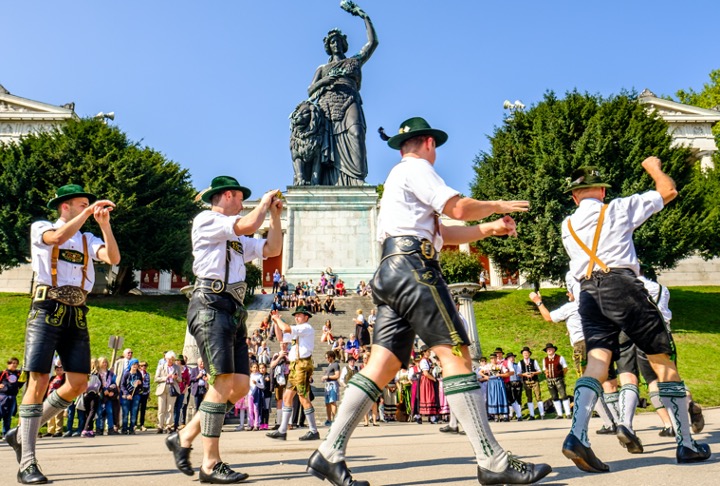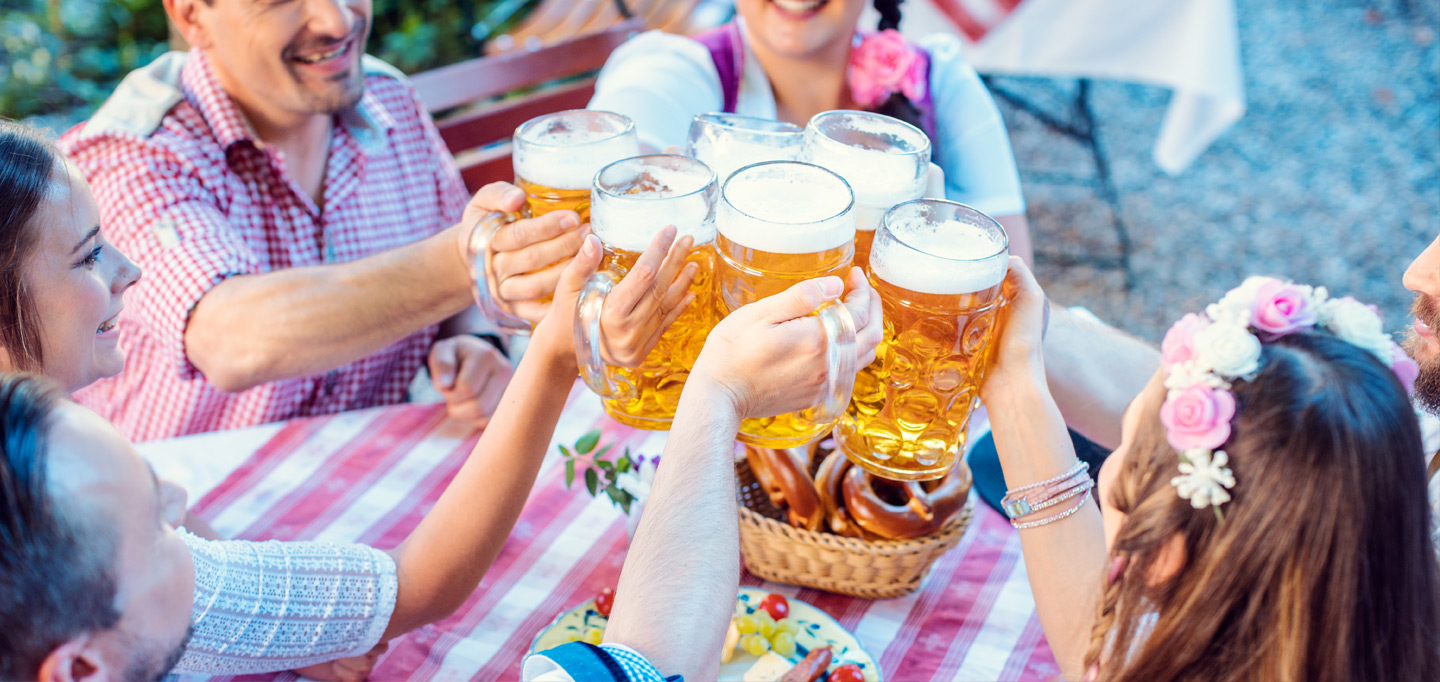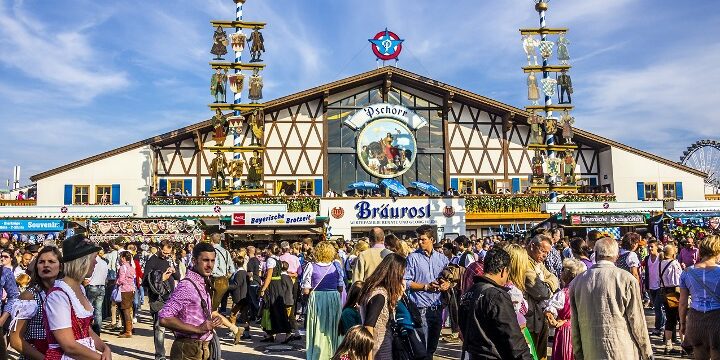Oktoberfest, one of the world’s most famous festivals, began with a royal wedding in 1810 and has grown into a local and international holiday. On October 12th of that year, Crown Prince Ludwig of Bavaria, later known as King Ludwig I, married Princess Therese of Saxony-Hildburghausen. The citizens of Munich were invited to join in the celebrations, and they flocked to the fields in front of the city gates. These fields were later named “Theresienwiese” (Therese’s Meadow) in honor of the bride, and this location has been the festival’s site ever since.
The wedding festivities culminated in a horse race, which was such a success that it was decided to repeat it the following year. This marked the birth of the annual Oktoberfest tradition.
Early Development and Agricultural Roots
In the early years, Oktoberfest was primarily a local celebration with a focus on Bavarian agriculture. In 1811, an agricultural show was added to the festival, which showcased Bavaria’s farming and livestock industries, promoting advancements in agricultural technology. The show became an integral part of Oktoberfest, and it continues to be held every four years as a reminder of the festival’s roots.
While the agricultural show maintained prominence in the early 19th century, the festival gradually began to evolve. By the 1830s, amusement rides and beer stands started appearing, slowly shifting the focus from agriculture to more recreational activities. This transition laid the groundwork for the modern Oktoberfest as we know it today.

Oktoberfest in the 19th Century: A Celebration of Bavarian Identity
The 19th century was a period of growth for Oktoberfest, during which it began to embody Bavarian culture and identity. The festival expanded in both size and offerings, and in 1818, the first carousels and swings were introduced to entertain attendees. Beer became a central element, and local breweries began to serve their finest brews at the event.
Significant changes to Oktoberfest took place during this period. In 1850, a statue known as the “Bavaria” was erected on Theresienwiese. This statue, along with a nearby hall of fame (Ruhmeshalle), was commissioned by King Ludwig I to honor Bavarian heroes, further solidifying the festival’s role in promoting Bavarian heritage.
In 1887, the parade of breweries became an official part of the festival’s opening ceremonies. This parade, led by the Münchner Kindl (a symbol of Munich), signaled the start of the beer celebration, with horse-drawn carts transporting barrels of beer to the festival grounds.
The Early 20th Century: Modernization and Challenges
By the early 20th century, Oktoberfest had grown into a massive cultural event, drawing crowds from across Germany and beyond. In 1910, the 100th anniversary of Oktoberfest was celebrated in grand style, with over 12,000 hectoliters (approximately 317,000 gallons) of beer consumed during the event. New technologies and amusements were introduced, such as electric lights and modern rides, contributing to the increasingly diverse entertainment options at the festival.
However, the festival was interrupted by global events. World War I (1914-1918) brought Oktoberfest to a halt, and between 1914 and 1918, the event was replaced by smaller autumn festivals. Similarly, during World War II, Oktoberfest was canceled between 1939 and 1945 due to the ongoing conflict and economic challenges. Instead, a smaller version of the festival known as “Autumn Festival” was held on a limited scale, with reduced festivities and no beer served.
The Post-War Revival and Globalization of Oktoberfest
After World War II, Oktoberfest made a triumphant return in 1949, reestablishing itself as a central part of Bavarian culture. Post-war Germany, eager to rebuild and strengthen its traditions, embraced the festival with enthusiasm. The 1950s saw the modernization of the event, with new rides, food options, and the introduction of more international visitors. The traditional opening ceremony—marked by the mayor of Munich tapping the first beer barrel and shouting “O’zapft is!” (“It is tapped!”)—was introduced in 1950, becoming a hallmark of the event.
In the latter half of the 20th century, Oktoberfest grew far beyond its Bavarian origins to become an international phenomenon. Tourists from around the world began attending the event in increasing numbers, drawn by the unique combination of Bavarian culture, beer, music, and merriment. As a result, the festival expanded in size and scale, with larger beer tents and greater diversity in entertainment offerings.

Oktoberfest in the 21st Century: Tradition Meets Modernity
In recent decades, Oktoberfest has continued to evolve while remaining true to its roots. Today, it attracts more than six million visitors annually from around the globe, making it the world’s largest beer festival. Despite its global appeal, Oktoberfest has maintained its distinctly Bavarian character, with traditional dress (lederhosen and dirndls), oompah bands, and time-honored Bavarian cuisine.
Environmental sustainability has become a growing focus in recent years. In an effort to reduce waste, festival organizers have implemented measures such as reusable beer mugs and plates, and there has been a shift towards more energy-efficient technologies for rides and lighting.
Despite interruptions due to the COVID-19 pandemic in 2020 and 2021, Oktoberfest remains a symbol of Bavarian culture, heritage, and community spirit. Its continued popularity around the world highlights its unique ability to blend tradition with the contemporary festival experience.
A Celebration of History and Heritage
From its humble beginnings as a royal wedding celebration to its current status as a global cultural phenomenon, Oktoberfest is a festival steeped in history. Over two centuries, it has grown and transformed, reflecting the changing times while preserving the traditions that make it uniquely Bavarian. Today, it stands as a vibrant testament to Bavarian culture, inviting millions of people to raise a stein in celebration of heritage, community, and joy.


































